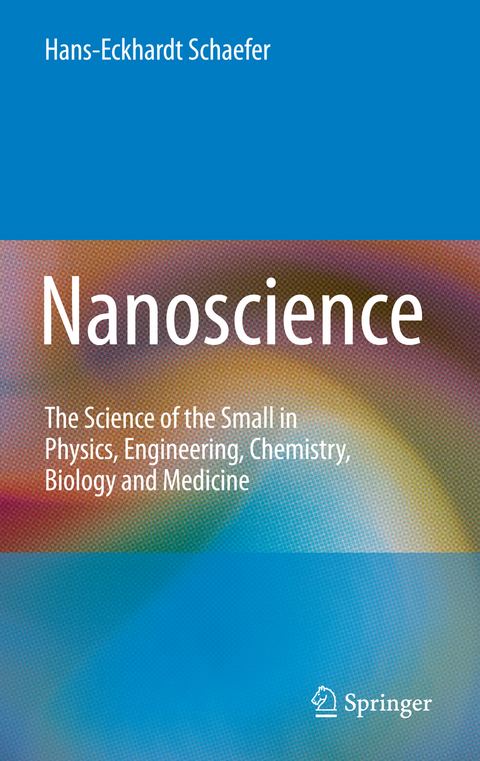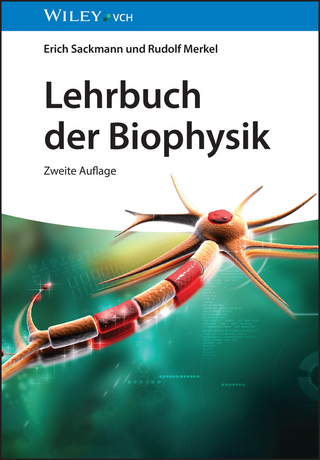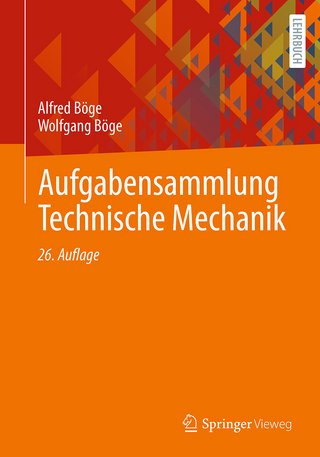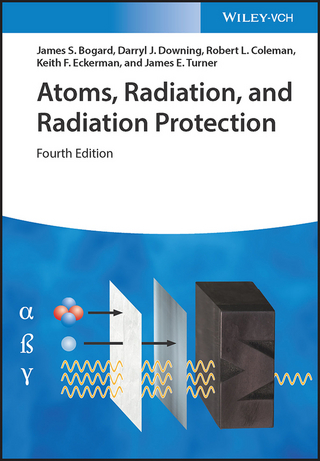
Nanoscience
Springer Berlin (Verlag)
978-3-662-51866-3 (ISBN)
Nanoscience stands out for its interdisciplinarity. Barriers between disciplines disappear and the fields tend to converge at the very smallest scale, where basic principles and tools are universal. Novel properties are inherent to nanosized systems due to quantum effects and a reduction in dimensionality: nanoscience is likely to continue to revolutionize many areas of human activity, such as materials science, nanoelectronics, information processing, biotechnology and medicine. This textbook spans all fields of nanoscience, covering its basics and broad applications. After an introduction to the physical and chemical principles of nanoscience, coverage moves on to the adjacent fields of microscopy, nanoanalysis, synthesis, nanocrystals, nanowires, nanolayers, carbon nanostructures, bulk nanomaterials, nanomechanics, nanophotonics, nanofluidics, nanomagnetism, nanotechnology for computers, nanochemistry, nanobiology, and nanomedicine. Consequently, this broad yet unified coverage addresses research in academia and industry across the natural scientists. Didactically structured and replete with hundreds of illustrations, the textbook is aimed primarily at graduate and advanced-undergraduate students of natural sciences and medicine, and their lecturers.
Prof. Dr. Hans-Eckhardt Schaefer received his Dr. rer. nat. in physics from Stuttgart University, Germany. His main research fields are solid state physics and nanoscience. He gave courses in nanoscience at Stuttgart University and is a guest professor in Japan, China, and South America. He received the Tammann Medal of the German Materials Research Society and the Lee Xun Research Award of the Institute of Metals Research, Chinese Academy of Sciences, Shenyang, China.
IntroductionIntroduction and Some Physical Principlesphysical principles .- MicroscopyMicroscopy - Nanoscopynanoscopy .- Synthesis 3. Synthesis .- NanocrystalsNanocrystals - Nanowiresnanowires - Nanolayersnanolayers .- Carbon NanostructuresCarbon nanostructures - Tubes, Graphenegraphene , Fullerenesfullerenes , Wave-Particle Dualitywave-particle duality .- Nanocrystalline MaterialsNanocrystalline materials .- NanomechanicsNanomechanics - Nanophotonicsnanophotonics - Nanofluidicsnanofluidics .- NanomagnetismNanomagnetism .- Nanotechnology for ComputersNanotechnology for computers , Memoriesmemories , and Hard Diskshard disks .- NanochemistryNanochemistry - From Supramolecular Chemistrysupramolecular chemistry to Chemistry on the Nanoscalechemistry on the nanoscale , Catalysiscatalysis , Renewable Energyrenewable energy , Batteriesbatteries , and Environmental Protectionenvironmental protection .- Biology on the NanoscaleBiology on the nanoscale .- NanomedicineNanomedicine .
Review on the entire book by Dr. Wolfgang Sprengel, Institute of Materials Physics, Graz University of Technology, Austria: "Despite the many books in nanosciences, there is no other book that treats the full spectrum of nanosciences in such a comprehensive and complete way. It is not a potpury of known topics but a new composition covering all areas of nanosciences. The book is very useful to graduate students and also to professors to design lectures. Also established researchers can still learn from this book. This comprehensive overview of various fields is highly desirable for further stimulation of successful research and advanced teaching and studying. This book is of high value for scientists, teachers, and graduate students involved in this field. Although there are many publications in the field of nanoscience and nanotechnology, I am not aware of another book which treats this field as comprehensively, farsightedly, and competently as this book. This is due to the composition of this book which makes all disciplines of nanoscience appear in a new light and which offers new insight and rich stimulation for concepts of teaching and planning of research projects. In conclusion, I would like to recommend this book to all graduate students and scientists active in the various field of nanoscience in teaching, academia and industry. It can be anticipated that this text can yield for years most stimulating inspiration for teachers and researchers since it presents and elucidates in a an excellent, attractive and comprehensive manner the fundamentals and intercorrelations of nanoscience."
Reviews on individual chapters by specialists:
Brent Fultz, Professor of Materials Science and Applied Physics, California Institute of Technology, Pasadena, USA: "I read with interest the text of Chapter 1 and the Table of Contents and enjoyed reading it. It is quite clean and the English is excellent. Chapter 1 provides a fine coverage of the underlying issuesin the physics and chemistry of nanoscience. I liked the presentation of those topics for which I was already familiar, and I found the explanations useful for learning about topics that were new to me. The style is well suited for an advanced textbook for graduate students and researchers. Researchers will also benefit from the extensive citations to the literature. The Table of Contents shows an ambitious coverage of a broad range of topics. I expect these other chapters will match the quality of Chapter 1, so I expect this book to be an impressive achievement."
Chapter 2 by Prof. Dr. Horst P. Strunk, Institut für Materialwissenschaft, Universität Stuttgart, Germany: "Microscopy - nanoscopy. This topic is very timely. The manuscript is written in a very concise and comprehensive manner, it describes the state of the art of microscopy in nanoscience rather clearly by including prominent examples from solid state physics, molecular chemistry, and biology. The well organized description of scanning probe microscopy, far-field optical microscopy beyond the diffraction limit, progress in electron microscopy, x-ray microscopy, and the development of atom probes makes this text an important source for students and scientists. I will always advise my students and colleagues to consult this very didactic text as a prerequisite for structural studies in nanotechnology down to the atomic scale."
Prof. Dr. R. Ghosh, Dept. of Bioenergetics, Institute of Biology, University of Stuttgart, Germany: "I very much enjoyed reading the manuscript of chapter 11. This is an excellent and concise tutorial-like overview of the most important nanosize aspects in modern biology, on recent research, measuring aspects and application issues. The chapter shows an impressive coverage of very topical subjects such as the nanostructure of the cell, nanomechanics of DNA and proteins, the structure and function of molecular motors, membrane channels, nanostructures of bone and teeth, photonic nanostructures of butterflies and beetles, the lotus leaf effect, food nanostructures and finally cosmetics. This well organized text with the many beautiful figures that can be directly used for my teaching and by graduate students for their advanced studies. Finally I very much appreciated the style and the selection of the topics of this chapter."
Prof. Dr. Lothar Ley, Institute of Condensed Matter Physics, University of Erlangen, Germany: "After reading chapter 5., I feel that this survey is very comprehensive. In this concise text a number of aspects can be discussed only briefly but since every aspect is backed by the relevant references, the reader can easily study the more extended literature. The wealth of the figures opens an additional rich source of information and will contribute to make the chapter a frequently quoted review. My congratulations to this manuscript. I will use this book in my lectures."
Univ. Prof. Dr. Heinz Krenn, Institute of Physics,Karl-Franzens-Universität Graz, Austria: "I enjoyed reading chapter 8. It is an experimentally sound survey of nanomagnetism which so positively contrasts other textbooks such as the book 'Nanomagnetism - Ultrathin Films, Multilayers, and Nanostructures' by D. L. Mills and J. A. C. Blend (2007). My congratulations for this comprehensive text. I will use it for my lectures and highly recommend it to students."
Dr. Hartmann Schaefer, former manager Medicinal Chemistry/Regulatory Affairs (Retired from Byk Gulden GmbH, now Nycomed GmbH): "I read with grerat pleasure the two chapters 10. and 12. The author succeeded in convincingly documenting the two fields in a good teaching style and a most transparent and compact presentation, amply illustrated by informative and elucidating figures. The chapter on nanochemistry yields an excellent survey of the recent developments of nanoaspects in basic and applied chemistry. The chapter on nanomedicine is a comprehensive text on this rapidly growing field. Finally, a competent discussion of risk assessment strategies and toxicity considerations is given which are prerequisites for the transfer of novel nano-methodologies into clinical assays. These chapters can be fully recommended to students and colleagues in academia and industries."
From the reviews:
"The twelve chapters are organized together well to create a logical natural structure. Each chapter contains an extensive list of references and is profusely illustrated with figures. ... of interest to researchers and graduate students in the broad field of nanoscience and nanotechnologies. It can be also useful for engineers who are involved in production and processing of nanomaterials for structural, functional and biomedical applications. I expect this book to have a significant impact on research in both fundamental nanoscience and practice concerning nanotechnologies." (I. A. Ovid'ko, Materials Physics and Mechanics, Vol. 11 (1), 2011)
| Erscheinungsdatum | 01.07.2016 |
|---|---|
| Zusatzinfo | XXIII, 772 p. |
| Verlagsort | Berlin |
| Sprache | englisch |
| Maße | 155 x 235 mm |
| Gewicht | 1205 g |
| Themenwelt | Naturwissenschaften ► Physik / Astronomie ► Angewandte Physik |
| Naturwissenschaften ► Physik / Astronomie ► Atom- / Kern- / Molekularphysik | |
| Naturwissenschaften ► Physik / Astronomie ► Festkörperphysik | |
| Technik ► Maschinenbau | |
| Schlagworte | Biotechnology • Fulleren • Fullerene • nanofluidics • Nanomaterial • Nanophotonics • nanotechnology |
| ISBN-10 | 3-662-51866-X / 366251866X |
| ISBN-13 | 978-3-662-51866-3 / 9783662518663 |
| Zustand | Neuware |
| Informationen gemäß Produktsicherheitsverordnung (GPSR) | |
| Haben Sie eine Frage zum Produkt? |
aus dem Bereich


